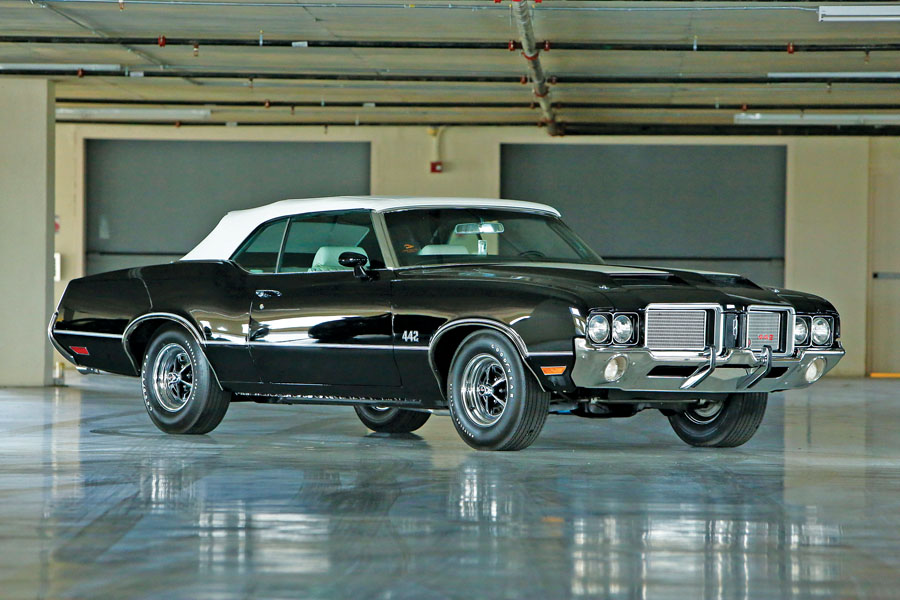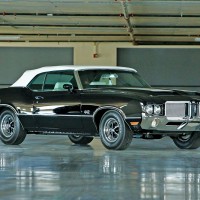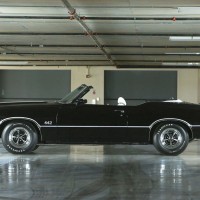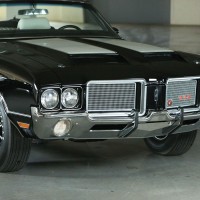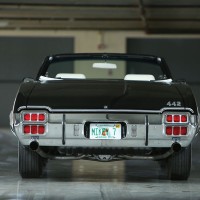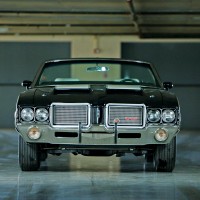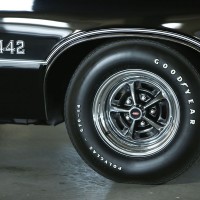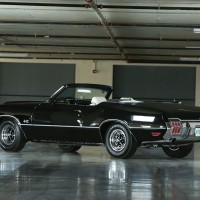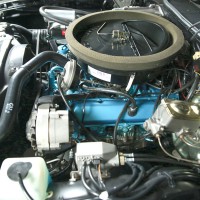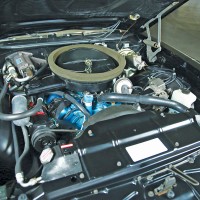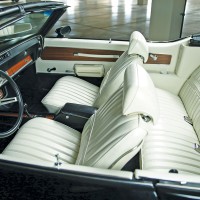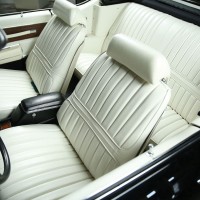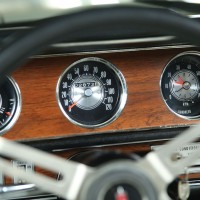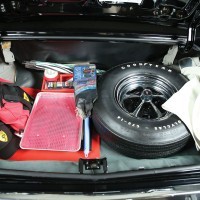- Rocket 455-cid V8 engine
- Automatic transmission
- Restored by Thornton Brothers
- Copy of window sticker
- Copy of broadcast sheet
- Restored to original specs
- Factory air conditioning
- Rare 8-track tape player
- Sports console
- Generously appointed from the factory
The popular and respected 442 Package included FE2 suspension with heavy-duty front and rear stabilizer bars, wide 14-by-7-inch wheels, louvered hood, special 442 grille, hood and body painted stripes, and 442 badging. You could choose from four body styles and you could also have a nice choice in powerplants. This excellent example runs with the big 455-cid unit with a 4-barrel carburetor, flared dual exhaust outlets and a specially sculpted rear bumper.
This 442 convertible has been beautifully and professionally restored by the Thornton brothers; this process has been photo documented, plus the Oldsmobile is accompanied by a copy of its window sticker and broadcast sheet. Presented as-original in Ebony Black with white interior (black dash and carpets), white soft top and white stripes, this is a well-optioned car that is deserving of attention.
This Cutlass 442 was first shipped from its Lansing, MI, final assembly point to Sandusky Chevrolet Company in Kingfisher, OK, and had an MSRP of $5,547.94, which included $1,894.94 worth of accessories. Key among this group is the 455-cid V8 engine. Among the other desirable factory options are automatic transmission, air conditioning, sports console, “anti-spin” rear end, Rocket Rally Pac, stereo tape player, various accessory lighting, remote outside mirror, AM/FM stereo radio, Soft-Ray glass, tilt steering wheel, cruise control and bumper guards, as well as power top, steering and brakes with front discs. Super Stock wheels were available in two styles, and this car features the chromed highlights style instead of the style that was color-keyed to the bodywork. Reported as outstanding throughout, this is a prime example of the respected and coveted Cutlass 442.
SCM Analysis
Detailing
| Vehicle: | 1972 Oldsmobile 442 Convertible |
| Years Produced: | 1968–72 (second generation) |
| Number Produced: | 928 (1972 442 convertible) |
| Original List Price: | $5,547.94 |
| SCM Valuation: | $18,000–$26,000 |
| Tune Up Cost: | $200 |
| Distributor Caps: | $14 |
| Chassis Number Location: | Plate on driver’s side of dash, visible through windshield |
| Engine Number Location: | Stamped on pad at driver’s front of block, just below cylinder head |
| Club Info: | Oldsmobile Club of America |
| Website: | http://www.oldsmobileclub.org |
| Alternatives: | 1970 Chevrolet Chevelle SS 454 LS5 convertible, 1969 Ford Mustang 428 CJ convertible, 1969 Plymouth GTX convertible |
| Investment Grade: | C |
This car, Lot 175, sold for $77,500, including buyer’s premium, at the Auctions America Hilton Head, SC, sale on October 31, 2015.
The Oldsmobile Cutlass 442 was introduced in 1964 as an option package for the F-85 and Cutlass and continued in production through 1980. The model was also offered from 1985 to 1987 and again from 1990 to 1991 before GM put a fork in it and called it done.
Most Oldsmobile 442 aficionados place the emphasis on the higher-performance years, which are usually correlated to the muscle car era, which ran from 1964 through 1972. By 1973, the new Olds 442 was redesigned, and while it remained a popular model line, the horsepower output was suffocated with increased emissions regulations, more weight and more corporate edicts that lowered performance.
Our subject car is part of the second generation of the body style, built from 1968 to 1972. During that generation, the 442 became its own model line from 1968 to 1971, with a specific VIN number assigned to the 442. The 1972 model was originally designated to be a body changeover year, with the new “Colonnade” body in play, but a pesky strike at GM put that off until the 1973 model.
With that brief 442 primer behind us, let’s take a specific look at our 1972 subject car.
The 442 was once again a styling and handling package in 1972. The VIN number did not tell you if the car was actually born as a 442 (although a U or a V in the fifth digit of the VIN number would denote the 455, but that was not specific to the 442 — only the X code denoted the W-30 455, which was only available in a 442 package). Starting with a 350 V8 Cutlass, you could order the W-29 442 package starting at $29. For that, buyers would get some badges and stripes, an upgraded suspension and faux hood louvers, and a different grille. There were plenty of other options as well, which could quickly take the base MSRP up to a hefty grand total.
From an Oldsmobile 442 hierarchy standpoint, our subject car falls one notch short of the top dog in the category, which is the W-30 model. Those cars were usually ordered by well-heeled gentlemen who wanted the performance of an all-out muscle car, in a more stylish touring package. The W-30 option consisted of a massive 455-ci L77 engine that produced 300 ponies when put to the test. The main selling feature, however, was 410 foot-pounds of torque that could easily shred a pair of Goodyears in short order. There where plenty of other options and models also available, such as the Hurst/Olds, that allowed buyers to create and build just about any configuration Cutlass they desired.
Unique options
Our subject car was ordered with a set of very unique, documented, and now sought-after options. While the original buyer of this car didn’t order the top-level W-30 455, he did come close with the optional V-code, 270-horse, 455 Rocket engine. Other notable options included factory air, 8-track player, Sports console, the W-25 ram-air hood, anti-spin differential, rear exhaust cutouts, and a host of other luxury items. In essence, the original owner of this car knew what he was doing and ordered a “near-W-30” example with all the creature comforts of a luxury coupe. And that didn’t come cheap, with the total tally coming to a heady $7,442.88 in 1972 — all backed up via a copy of the original window sticker.
A top-notch restoration
The highly regarded Thornton Brothers, of Telford, PA, restored our subject car. They specialize in GM A-body cars and have a well-known following for doing some of the best restorations in the business. I’ve personally discussed a few cars with them — and crawled all over some of their restorations. Their work is impeccable and extraordinarily correct, and their finished cars command a premium when sold at auction.
Our subject 442 was reported to be in near-perfect condition. The body panels, paintwork, engine bay, chassis and interior were all in pristine condition — and worthy of any show field. The color combination is also very desirable and easily adds 10% to the overall valuation. While the documentation is somewhat light, we do find copies of the original window sticker and broadcast sheet, which confirm the current build and configuration of the presentation.
Sought after and relatively rare
Production figures show 928 total Cutlass Supreme 442 convertibles built, with an additional 113 W-30 cars constructed in 1972. The special Hurst/Olds convertibles also add another 130 cars to the fold. Out of the 928 Cutlass Supreme 442 convertibles built, how many remain is anyone’s guess. However, peeling another layer off that onion would reveal far fewer cars with these options — and even fewer at this level of restoration. The reality is that this restoration was done for accolades — and certainly not to obtain a profit.
Very few 1972 442 convertibles are currently for sale. The cars have a tendency to stay put in their owners’ garages. When one does come up for sale, the values can range from $25,000 for a rather ordinary #3 driver to $75,000 for an exceptional example. The buyers of these cars also have a tendency to stay loyal to 442s. These cars are often sold from one Oldsmobile collector to another.
The SCM Pocket Price Guide pegs the 1972 convertible models at $18,000 to $26,000, which sounds like it needs to be updated, given the current market.
Naturally, it boils down to supply and demand for any car to command a premium. There weren’t a bunch of 1972 Oldsmobile 442 convertibles built and even fewer have survived. To complicate this, there are plenty of clones and replicas out there that were never (1972) 442s to begin with, so be careful and do your homework if you plan to purchase one. Options and colors can — and do — make a huge difference as well, so a well-appointed example will command a higher price.
Our subject car was highly restored. The cost of that restoration was reported to have exceeded the $77,500 selling price. There was no mention of the car being a numbers-matching example, but most of the auction houses would rather not suggest that, as cars are or aren’t matching numbers because of the widely varying definitions of the term.
The 411 on the 442
Given the slim offerings in the current market, the color combination, partial documentation and restoration costs, the buyer of this Oldsmobile did well — but so did the seller.
Had this car been offered in the public market via a private party sale (not an auction), I believe that the seller would have been hard pressed to fetch this sort of number for a 1972 442 convertible. Prospects would have researched the asking price and, frankly, thought the seller was crazy.
That said, an auction was likely the best option for the seller since buyers could see the quality of the car and realize the enormous investment put into it — which resulted in a great outcome for the seller. By the books, Lot 175 was well sold, but when you continue to peel more layers of that automotive onion, both parties should be pleased. ♦
(Introductory description courtesy of Auctions America.)
